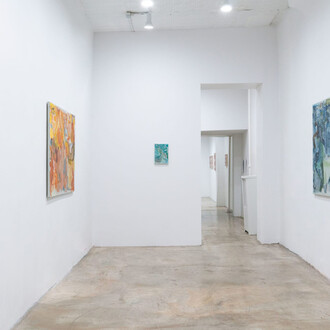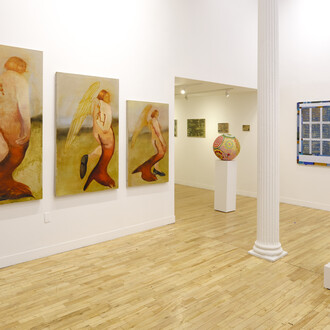Massey Klein Gallery is pleased to present Night Shift, a solo exhibition of new paintings by Aliza Morell.
In his essay The Kekulé Problem, Cormac McCarthy explains that creative thinking and problem solving take place in the unconscious mind, and this happens entirely without language. “Why is the unconscious so loathe to speak to us? Why the images, metaphors, pictures? Why the dreams, for that matter” McCarthy asks, later going on to explain, “My friend George Zweig calls this the Night Shift.”1
With the title of her debut at Massey Klein, Morell extends this concept to include the labor of painting, and to describe her images where repeating forms shift and echo in black fields. In new oil and acrylic paintings on linen, the Night Shift, an unknowable place of constant potential, comes into focus. Freed from the body, like spirits, the hands pictured in Morell’s work embody possibility. To achieve lucidity in a dream, it has been said to look at your hands. This rhymes with the special depiction of hands throughout the history of painting, since its earliest days. Agency and transposition whisper through the hands in paintings from ancient times to the Renaissance and across the present moment.
Seduction and alchemy manifest in the reference and treatment of plant life. Blossoming from lines–the most elastic of forms–turned vines, her flora evades clear classification. The night blooming moonflower (with its hallucinatory properties) grew into the work after one of these plants sprouted, or volunteered in botanical speak, outside a bodega on her route home. Its single, cylindrical petal unfurls like an open palm, animate, with life lines etched, as it waits for moths or bats to land. Drawings of the moonflower became a touch point for this world.
Black grounds feature prominently, amplifying her glowing symbols while holding mystery. Black represents the sum and absence of all colors, depending on light or pigment. The most vivid of her characters however is color itself, invoked like a polymorphous magical substance, as Michael Taussig describes in his book What Color is the Sacred. Perhaps, fuchsia itself is blossoming.2 Ultimately, this work has a sensory agenda. The dream and the problem to be solved here is one of painting itself, with all the meaning that color and movement can imbue. “Why the images, metaphors, pictures? Why the dreams, for that matter?” For Morell, painting is a good place to look.
Aliza Morell holds an MFA from Mason Gross School of the Arts at Rutgers University (2014) and a BFA from The School of the Art Institute of Chicago (2005). Morell’s work has been shown at numerous venues in New York including Thierry Goldberg Gallery, Knockdown Center, Elijah Wheat Showroom, Pioneer Works, and Small Editions, as well as Glass Rice (San Francisco, CA), Tinney Contemporary (Nashville, TN), Tempus Projects, (Tampa, FL), and Camayhus Gallery (Atlanta, GA), among many others. Additionally, work by the artist has been presented at Spring/Break Art Show in New York and PULSE Miami Beach. Morell’s work has been featured in New American Paintings (2022, 2017, 2014), Hyperallergic, Create Magazine, and Two Coats of Paint. The artist has completed a number of artist residencies, including Vermont Studio Center (Johnson, VT), ACRE (Steuben, WI), Oxbow (Sautatuc, MI), and Harold Arts (Chesterhill, OH). Morell currently lives and works in Ridgewood, Queens. An essay by Molly Ledbetter accompanies the exhibition.
1 McCarthy, Cormac. (April 20, 2017). "The Kekulé Problem: Where did language come from?". Nautilus. No. 47. 2 Taussig, Michael. (2009). What Color is the Sacred?. The University of Chicago Press.
















